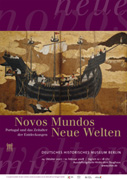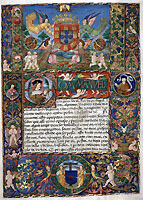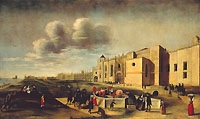


Prologue
| Portugal in the Middle Ages
| Conditions at the Start
| Voyages of Discovery
Cartography and Nautics
| New Worlds – Old Empires
| Portugal Overseas
| Art and Curiosity Cabinets
Portugal in the 16th Century
| International Conflicts
| Foreign Images
Under Dom Manuel I “the Fortunate” (ruled 1495-1521) Portugal experienced an economic and cultural upswing. With the expansion of the colonial empire the Portuguese crown became one of the wealthiest monarchies in Europe. Lisbon developed into the central metropolis of world economy with numerous foreign trading offices. The city was a place of exchange for geographic knowledge and the site of extensive new construction. Far into the 16th century it functioned as the economic and cultural hub between numerous overseas regions and Europe.
Reform and the establishment of a central administration by the crown secured the inner stabilization of the country. In foreign policy the kingdom strove to establish a personal union with Spain under the leadership of the House of Aviz. This rapprochement with Spain was also the reason for ordering the forced conversion of the Jews to Christianity.

Leitura Nova, Frühneuzeitliche Gesetzessammlung,
Portugal, 1521
Lissabon, Instituto dos Arquivos Nacionais / Torre do Tombo

Ansicht des Hieronymusklosters und des Ufers von Belém, Filipe Lobo, 1657–1660
Lissabon, Museu Nacional de Arte Antiga
